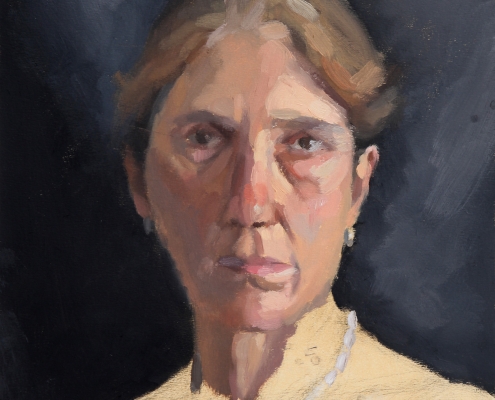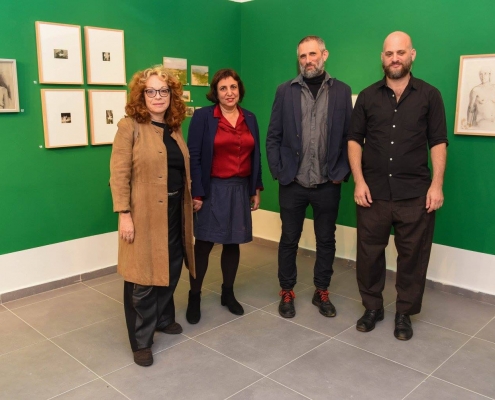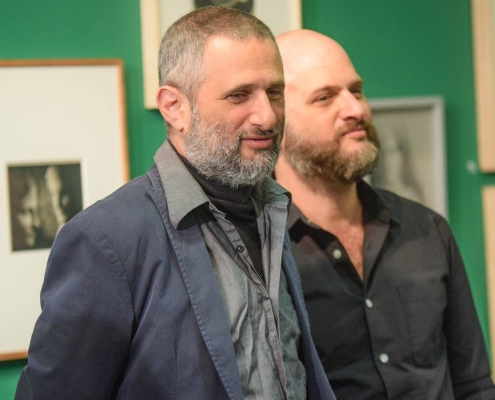לא חשוב לא חשוב , תערוכה | It’s not important, doesn’t matter , Exhibition
לא חשוב לא חשוב, עלמא גרשוני ואורי גרשוני, הסדנא לאמנות רמת אליהו, אוצרת : אורית חסון ולדר
* English follows below
“בבית הספר הייתה לי הפתעה דוד פרה שאני אוהבת בא לקחת אותי.” כך מתחיל הטקסט שנכתב לפני 15 שנה וכך ממשיך: “ועכשיו אמרתי לדוד פרה את כל מה שכתבתי עכשיו ועכשיו אמרתי לו את כל מה שעשינו עד עכשיו וגם הזכרתי לו מה לכתוב וצרחתי עליו: לא חשוב לא חשוב“.
בתערוכה המשותפת לעלמא גרשוני ולאורי גרשוני הם חוזרים לעבודה משותפת שיצרו לפני 15 שנה והיא מהווה עוגן קונקרטי לתערוכה. ביצירה זו יש, לדבריהם, רגע מכונן בו הובן מעשה היצירה בהקשר לזמן ומשך והכרה בכך שהרגע עליו מדווחים הוא לעולם הרגע שאחרי. לצד נוכחות העבר מתקיים עכשיו מפגש בזמן הווה וממשיך את העיסוק בעבר, ב”תולדות” וב”אבות האמנות והצילום”.
זו אינה עוד תערוכה רכילות משפחתית על שושלת גרשוני, גם לא תערוכה בנוסח: “אבות ובנים” אך עם זאת הקשר המיוחד בין אורי הדוד ועלמא האחיינית הוא מרכיב חשוב בהתהוות התערוכה.
חלל הגלריה הופך למעין “מוזיאון זוטא” בו המוצגים מקוטלגים וממוספרים ויש בו דגש על אופני התצוגה ולא רק על האובייקטים האמנותיים. התלייה המעורבת טווה חוטים בין האוסף של אורי לבין הציורים של עלמא ובמרכזה יחסי ציור וצילום והחשדנות ההדדית בין המדיה.
ריבוי המודלים, ה”טבע דומם”, דיוקנות ושאר הנושאים עובדים ככלי משחק השאולים מתולדות האמנות ולעולם של מאסטרים בציור וצילום: טורסו, פסלים יווניים, העתקים של יצירות מקור, כל אלו מזמינים מחשבה אודות מתודה ותרגול של ציור. התערוכה מציעה מחשבה חדשה על חיקוי, על שיכפול ועל חזרה, כשצילום וציור מהדהדים אחד את השני.
אורי, הצלם מופיע הפעם, כבעל האוסף, בתפקיד המשמר, המקבע, זה שלוכד דימויים, והופך כדבריו “דבר זר לשלו”, כך הוא מציג צלמים יידועי שם: וויליאם הנרי פוקס טלבוט, נדאר, לני ריפנשטאל לצד צלמים אנונימיים שהוא אוהב שהקשר שלו עם תצלומיהם גם הוא אינטימי. הצגת האוסף הוא צעד נוסף הממשיך מהלכים קודמים בהם אורי צילם את הבית של טלבוט מאבות הצילום ומהלכים של חזרה לטכניקות מראשית ימי הצילום.
עלמא ציירת ריאליסטית שזו לה תערוכת בכורה מציגה רישומים, ציורי שמן ועבודות בטכניקת גריזיי ובהן פורטרטים, ציורי נוף וטבע דומם. גם כשהיא ניצבת מול מודל נתון מראש, היא מטעינה אותו בנשימה נוספת משלה. המבט שלה חודר את שכבות המודל המחזיר(ה)לה מבט .היא “מחייה” במכחולה קבקבים אדומים, מעירה מודליסטיות מנומנמות משנתן ובעבודותיה נוכח תמיד משהו נוסף שהיא מראה לנו: זווית פה מעוקמת, עגמומיות קלה כשהמקצב הרישומי, ציורי שלה מצטרף ל”ראיית הרנטגן” .עלמא לעולם מתרגמת לנו הצופים ללא חנופה ושיקולים אסתטיים של טעם טוב, ומוסרת מצג נתונים של מה שראתה ברגע שלפני.
כשעלמא היתה ילדה אסף אותה אורי מבית הספר. הקניות, השוקו הבננות ועוגת הקרם, שקנו בדרך הביתה הפכו בסופו של דבר לטבע דומם ונוצר הטקסט המשותף.
בסדנה שהעבירו בסדנא לאמנות לכיתת אמן לילדי בית הספר ויתקין בשכונת רמת אליהו שוחזרה אותה ארוחת בוקר ושוב רשמו הילדים את המצרכים לפני שנאכלו. העבודות הללו יוצגו בגלריה של כל הדברים, ארון תצוגה לעבודות מחוץ למעגלי האמנות .
בחלון אמנית תציג עדנה אוחנה פסל חדש בשחור לבן שהוא מעין הכלאה בין מגהץ שעווה ושיער, הקורץ למסורת הרדי מייד בדאדא אך גם מתכתב עם אמנות פמיניסטית המשלבת אלמנטים גופניים. צירוף השיער השחור למגהץ הלבן מנסח מחדש את המרחב הדומסטי של עבודות הבית ומאתגר תפיסות בנוגע לתפקידים נשיים.
פתיחה יום שבת, 17.12.16
אמנים אורי גרשוני, עלמא גרשוני, עדנה אוחנה
אוצרות אורית חסון
Never mind, never mind / Alma Gershuni and Uri Gershuni
Curator: Orit Hasson Walder
“When I was at school, I had a surprise: My beloved ‘Uncle Cow’ came to pick me up.” That’s the beginning of a text written 15 years ago. It continues: “Then I told ‘Uncle Cow’ everything I wrote now and now I told him everything we did up to now and reminded him what to write and yelled at him, Never mind!”
In this joint exhibition, Alma Gershuni and Uri Gershuni return to the artwork they made together 15 years ago, which is the concrete anchor of the exhibition. They described the work as being a foundational moment in which the act of creation was reconstructed in the context of time and duration. With that, they recognized that the moment on which they report is forever the moment after the event. Alongside the presence of the past, an encounter now takes place in the present, continuing their engagement in the past, in “history” and the “founding fathers of the art of photography.”
This is not another exhibition of family gossip about the Gershuni dynasty, nor is it an exhibition of two generations of artists, and yet, the unique relationship between Uri and his niece Alma is an important element in how the exhibition came into being.
The gallery space has been turned into a kind of miniature museum in which findings have been catalogued and numbered, with the emphasis on modes of exhibition, not only on the art objects. The diversity of the hanging creates a web of lines between Uri’s collection and Alma’s paintings; at the center lie the relationship between painting and photography and the mutual distrust between the two mediums.
The many models, still life, portraits and other subjects work as tools of the game borrowed from art history and the world of the great masters of painting and photography: the torso, Greek sculpture, copies of original masterpieces – all stimulate thoughts on the method and practice of painting. The exhibition offers a new way of thinking about mimesis, replication and repetition, with photography and painting resonating with each other.
Uri, the photographer, appears this time as a collector, in the role of the conservator, the one who determines the canon, he who captures images, and, as he states, transforms “something foreign into his own.” He presents well-known photographers: William Henry Fox Talbot, Nadar, and Leni Riefenstahl alongside of anonymous photographers whose work he loves and with whose oeuvre he has an intimate connection. Exhibiting his collection is an additional step continuing prior works, such as Uri’s photographs of the home of one of the “founding fathers” of photography, Talbot, and Uri’s return to some of the earliest photographic techniques.
This is Alma Gershuni’s first exhibition. A realistic painter, she is showing drawings, oil paintings, and works in grisaille (portraits, landscapes and still life). Even when she stands facing a given model, she infuses it with something extra of her own. Her gaze penetrates the layers of the model who gazes back at her. Her paintbrush animates red bottles, wakes drowsy models, and something additional is always present in her works, whether is it a crooked angle or a somewhat dark mood when her drawing/painting style is combined with her “X-ray vision.” Alma always translates for viewers without flattery or aesthetic considerations of good taste, transmitting the facts about what she saw at the preceding moment.
.
When Alma was young, Uncle Uri used to pick her up from school. Shopping for chocolate milk, bananas and a cream cake purchased on their way home has finally become a still life, and a joint text was created.
In the master class at the Art Workshop that the two facilitated for children from the Vitkin School in Ramat Eliyahu, the breakfast was recreated, and the children once again drew the items before eating them. These works will be on exhibit in the Gallery of All Things, an exhibition showcase for non-art works
.
Edna Ohana is exhibiting a new sculpture in the Artist’s Window. The black and white sculpture is a kind of hybrid between an iron made of wax and hair, with a glance to the Dada tradition of the readymade, yet also corresponding with feminist art integrating elements from the body. Combining the black hair with the white iron reconfigures the domestic space of housework, challenging perceptions of women’s roles.
.














